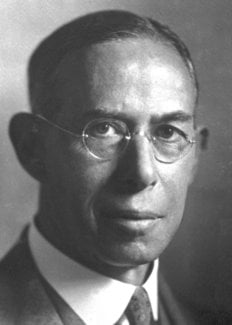Joseph Erlanger
Biographical

Joseph Erlanger was born on January 5, 1874, at San Francisco, California. He is the son of Herman and Sarah Erlanger.
Studying chemistry at the University of California, he received the degree of B.S. of that University and later went to Johns Hopkins University to study medicine, where he obtained his M.D. degree in 1899. After a year of hospital training at the Johns Hopkins Hospital, he was appointed assistant in the Department of Physiology at the Medical School there. Until 1906 he stayed there, being successively Instructor, Associate, and Associate Professor. He was then appointed the first Professor of Physiology in the newly established Medical School of the University of Wisconsin, where one of his pupils was H. S. Gasser, who later collaborated with him. In 1910 he was appointed Professor of Physiology in the reorganized Medical School of the Washington University, St. Louis. In 1946 he retired as chairman of this school and is now emeritus professor there.
Erlanger’s chief research has been done in the fields of electrophysiology and the physiology of the circulatory system. He has studied the principles of sphygmomanometry and devised a recording sphygmomanometer, with which he studied, in man, the influence of pulse pressure on kidney secretion and on orthostatic albuminuria. Later, he devised a clamp with which the auriculo-ventricular bundle of the mammalian heart could be reversibly blocked, and with this device he studied the problems associated with the functions of this bundle.
In 1922, in collaboration with Gasser, Erlanger adapted the cathode-ray oscillograph for the study of nerve action potentials and this led to the work for which Erlanger and Gasser were given the Nobel Prize for Medicine or Physiology in 1944. Erlanger has also worked on metabolism of dogs with shortened intestines, on traumatic shock and on the mechanism of the production of sound in arteries.
Erlanger has received honorary doctorates of the Universities of California, Wisconsin, Pennsylvania, and Michigan.
In 1906, he married Aimée Hirstel, who died in 1959. They had three children, Margaret (b. 1908), Ruth Josephine (b. 1910), Herman (1912-1959).
This autobiography/biography was written at the time of the award and first published in the book series Les Prix Nobel. It was later edited and republished in Nobel Lectures. To cite this document, always state the source as shown above.
Joseph Erlanger died on December 5, 1965.
Nobel Prizes and laureates
Six prizes were awarded for achievements that have conferred the greatest benefit to humankind. The 14 laureates' work and discoveries range from quantum tunnelling to promoting democratic rights.
See them all presented here.
